In the broader context of racism in the United States, mass racial violence in the United States consists of ethnic conflicts and race riots, along with such events as:
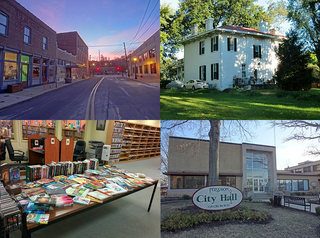
Ferguson is a city in St. Louis County, Missouri, United States. It is part of the Greater St. Louis metropolitan area. Per the 2020 census, the population was 18,527, and predominantly black.

The Omaha Race Riot occurred in Omaha, Nebraska, September 28–29, 1919. The race riot resulted in the lynching of Will Brown, a black civilian; the death of two white rioters; the injuries of many Omaha Police Department officers and civilians, including the attempted hanging of Mayor Edward Parsons Smith; and a public rampage by thousands of white rioters who set fire to the Douglas County Courthouse in downtown Omaha. It followed more than 20 race riots that occurred in major industrial cities and certain rural areas of the United States during the Red Summer of 1919.
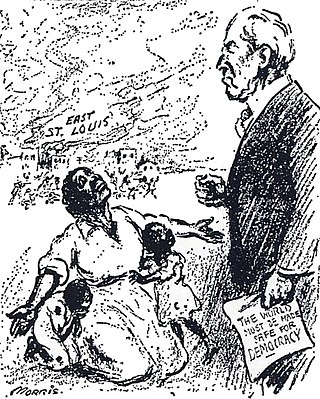
The East St. Louis massacre was a series of violent attacks on African Americans by white Americans in East St. Louis, Illinois between late May and early July of 1917. These attacks also displaced 6,000 African Americans and led to the destruction of approximately $400,000 worth of property. They occurred in East St. Louis, an industrial city on the east bank of the Mississippi River, directly opposite the city of St. Louis, Missouri. The July 1917 episode in particular was marked by white-led violence throughout the city. The multi-day rioting has been described as the "worst case of labor-related violence in 20th-century American history", and among the worst racial riots in U.S. history.
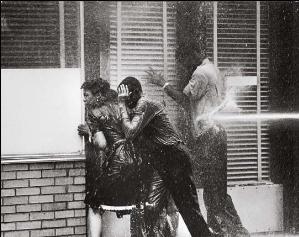
The Birmingham campaign, also known as the Birmingham movement or Birmingham confrontation, was an American movement organized in early 1963 by the Southern Christian Leadership Conference (SCLC) to bring attention to the integration efforts of African Americans in Birmingham, Alabama.

Facilities and services such as housing, healthcare, education, employment, and transportation have been systematically separated in the United States based on racial categorizations. Segregation was the legally or socially enforced separation of African Americans from whites, as well as the separation of other ethnic minorities from majority and mainstream communities. While mainly referring to the physical separation and provision of separate facilities, it can also refer to other manifestations such as prohibitions against interracial marriage, and the separation of roles within an institution. The U.S. Armed Forces were formally segregated until 1948, as black units were separated from white units but were still typically led by white officers.
The 1943Detroit race riot took place in Detroit, Michigan, from the evening of June 20 through to the early morning of June 22. It occurred in a period of dramatic population increase and social tensions associated with the military buildup of U.S. participation in World War II, as Detroit's automotive industry was converted to the war effort. Existing social tensions and housing shortages were exacerbated by racist feelings about the arrival of nearly 400,000 migrants, both African-American and White Southerners, from the Southeastern United States between 1941 and 1943. The migrants competed for space and jobs against the city's residents as well as against European immigrants and their descendants. The riot escalated after a false rumor spread that a mob of whites had thrown a black mother and her baby into the Detroit River. Blacks looted and destroyed white property as retaliation. Whites overran Woodward to Veron where they proceeded to violently attack black community members and tip over 20 cars that belonged to black families.
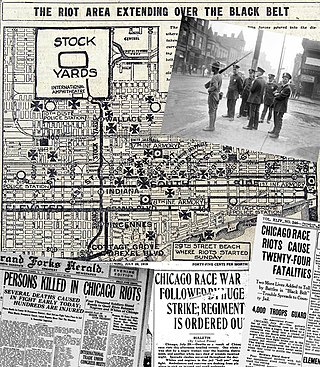
The Chicago race riot of 1919 was a violent racial conflict between white Americans and black Americans that began on the South Side of Chicago, Illinois, on July 27 and ended on August 3, 1919. During the riot, 38 people died. Over the week, injuries attributed to the episodic confrontations stood at 537, two-thirds black and one-third white; and between 1,000 and 2,000 residents, most of them black, lost their homes. Due to its sustained violence and widespread economic impact, it is considered the worst of the scores of riots and civil disturbances across the United States during the "Red Summer" of 1919, so named because of its racial and labor violence. It was also one of the worst riots in the history of Illinois.
Riots often occur in reaction to a perceived grievance or out of dissent. Riots may be the outcome of a sporting event, although many riots have occurred due to poor working or living conditions, government oppression, conflicts between races or religions.
The Harlem riot of 1935 took place on March 19, 1935, in New York City, New York, in the United States. It has been described as the first "modern" race riot in Harlem, because it was committed primarily against property rather than persons. Harlem is a northern neighborhood on Manhattan Island in New York City whose population at the time was predominantly African American.
Rubey Mosley Hulen was a United States district judge of the United States District Court for the Eastern District of Missouri. In July 1950, Hulen issued an injunction requiring the City of St. Louis, Missouri to open its fairgrounds and Marquette swimming pools to swimmers of all races.

Fairground Park is a municipal park that opened in 1908 in St. Louis, Missouri. It was originally a privately owned facility, first used by the St. Louis Agricultural and Mechanical Association for the St. Louis Exposition from 1856 through 1902. However, the Civil War interrupted the annual fair when the Fairgrounds were used as a Union encampment known as Benton Barracks. The annual exposition ceased in 1902 as preparations for the 1904 World's Fair began.
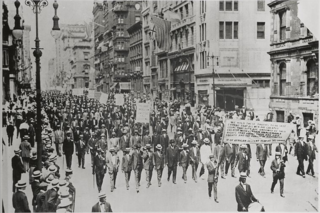
The Negro Silent Protest Parade, commonly known as the Silent Parade, was a silent march of about 10,000 African Americans along Fifth Avenue starting at 57th Street in New York City on July 28, 1917. The event was organized by the NAACP, church, and community leaders to protest violence directed towards African Americans, such as recent lynchings in Waco and Memphis. The parade was precipitated by the East St. Louis riots in May and July 1917 where at least 40 black people were killed by white mobs, in part touched off by a labor dispute where blacks were used for strike breaking.

The Ferguson unrest was a series of protests and riots which began in Ferguson, Missouri on August 10, 2014, the day after the fatal shooting of Michael Brown by FPD officer Darren Wilson. The unrest sparked a vigorous debate in the United States about the relationship between law enforcement officers and Black Americans, the militarization of police, and the use-of-force law in Missouri and nationwide. Continuing activism expanded the issues by including modern-day debtors prisons, for-profit policing, and school segregation.
From 1974 to 1976, the court-ordered busing of students to achieve school desegregation led to sporadic outbreaks of violence in Boston's schools and in the city's largely segregated neighborhoods. Although Boston was by no means the only American city to undertake a plan of school desegregation, the forced busing of students from some of the city's most impoverished and racially segregated neighborhoods led to an unprecedented level of violence and turmoil in the city's streets and classrooms and made national headlines.
The Anacostia Pool riot took place on June 29, 1949, at a recently-desegregated public swimming pool in the Anacostia neighborhood of Washington, D.C. After two days of tense confrontations between white and black patrons of the pool, a two-hour large-scale disturbance involving 450 people resulted in five arrests and at least four serious injuries. Bill Mabry, one of the black swimmers involved, called the incident “Washington’s first race riot.” Despite pressure to relax the enforcement of the federal government's nonsegregation policy, the Department of the Interior stated that “no backward step of any sort should be made in effectuating the President’s Civil Rights program,” specifically with respect to Washington, DC.

The Washington race riot of 1919 was civil unrest in Washington, D.C. from July 19, 1919, to July 24, 1919. Starting July 19, white men, many in the armed forces, responded to the rumored arrest of a black man for the rape of a white woman with four days of mob violence against black individuals and businesses. They rioted, randomly beat black people on the street, and pulled others off streetcars for attacks. When police refused to intervene, the black population fought back. The city closed saloons and theaters to discourage assemblies. Meanwhile, the four white-owned local papers, including the Washington Post, fanned the violence with incendiary headlines and calling in at least one instance for mobilization of a "clean-up" operation.
The racial composition of swimming and other aquatic sports has long been influenced by the history of segregation and violence at pools as well as the building patterns of public and private pools in America.

Nude swimming in US indoor pools was common for men and boys from the late 1880s until the early 1970s, but rare for women and girls. For much of that time period, indoor pool use was primarily for physical education or athletic competition, not recreation. Male nude swimming had been customary in natural bodies of water, which was not viewed as a social problem until the 18th century. When the tradition of skinny-dipping in secluded spots had become more visible with urbanization, indoor pools were first built in the 19th century in part to address this issue by moving male swimming indoors. For the first decades of the 20th century, male nude swimming was associated with a trope of the "old swimming hole" as representing childhood innocence and adult masculinity. In their own classes, nudity was rare for girls based upon an assumption of modesty, but might include young children. Prepubescent boys might be nude in mixed-gender settings, including the presence of female staff, public competitions, and open houses for families.











